
The Mariinsky Palace is one of the palaces of St. Petersburg, which is an outstanding monument of history and architecture.
The Mariinsky Palace was built in the first half of the 19th century by order of Nicholas I, for his daughter, Princess Maria, on the occasion of her wedding to the Duke of Leuchtenberg.
The architect of the palace was A. I. Stackenschneider.
During the history (more detailed history of the Mariinsky Palace is given at the end of this article) The Mariinsky Palace has repeatedly served as the center of the political and public life of the country.
For this reason, the Mariinsky Palace is one of the three "political" palaces of St. Petersburg. The other two are the Winter Palace (now the Hermitage) and the Tauride Palace.
Today, the building of the former Mariinsky Palace is an architectural monument and attracts attention with its monumentality, subtly combined with the elegance of forms and the play of volumes.
From the outside, the Mariinsky Palace looks almost the same as when its doors first opened (in 1845).
The main facade of the palace faces St. Isaac's Square, to The blue bridge over the Moika River. The bridge, during the construction of the Mariinsky Palace, was expanded to 97.3 meters, which made the facade of the palace even more solemn.
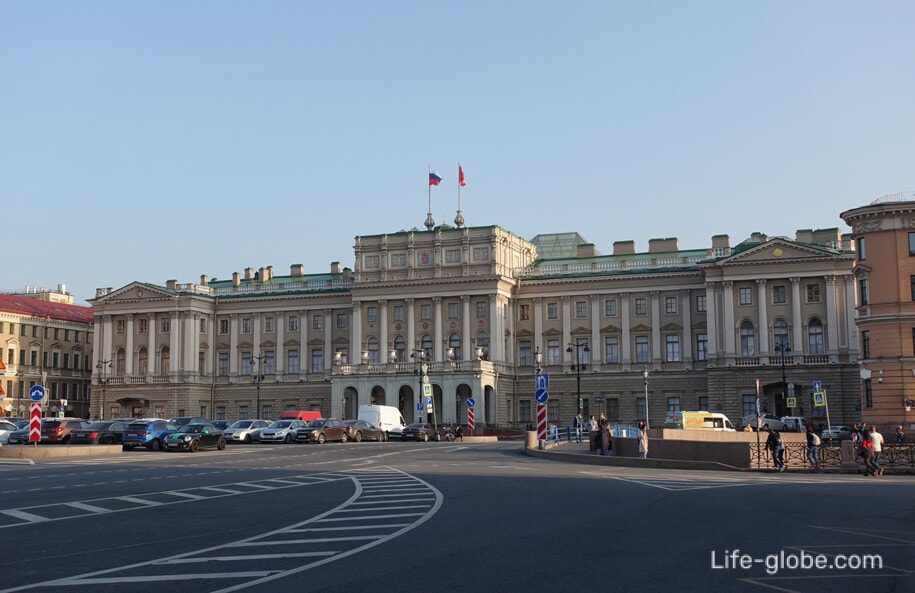
View of the Mariinsky Palace, the Blue Bridge and the Moika River
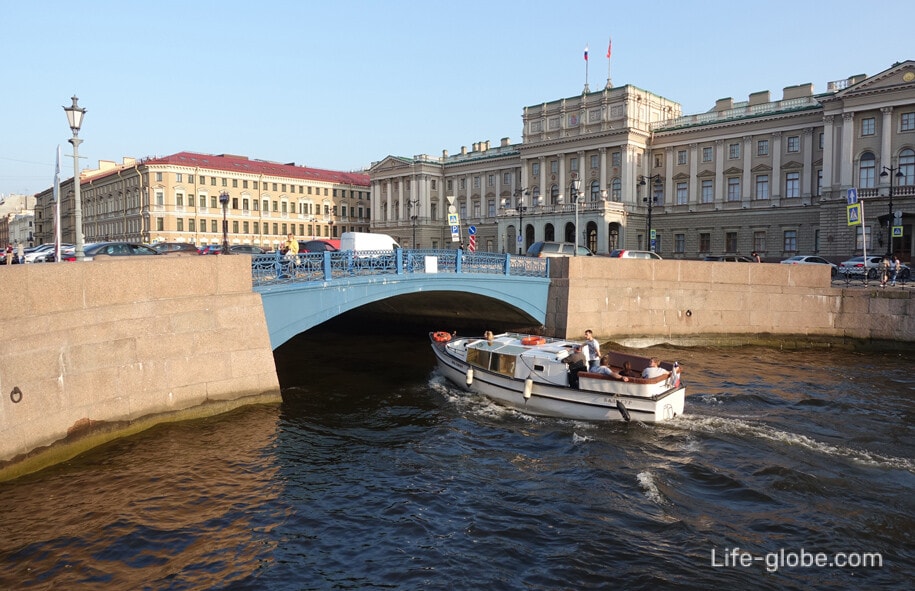
Architecturally, the main facade of the Mariinsky Palace has a prominent central part (the main entrance) and two wings.
The facade is decorated with stucco decorations, a coat of arms, columns and pilasters with capitals. Particularly striking is the protruding balcony at the second floor level and the windows that are different in shape and size.
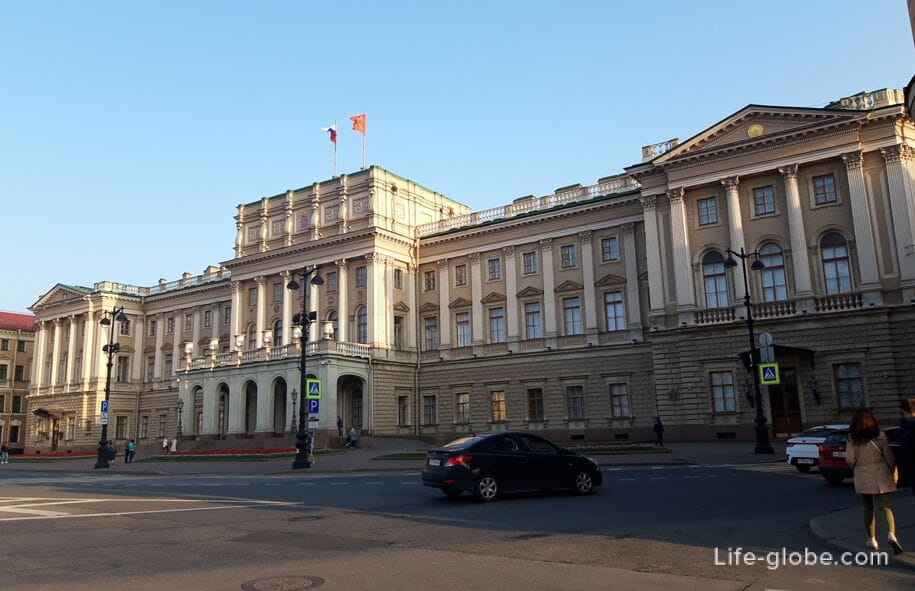
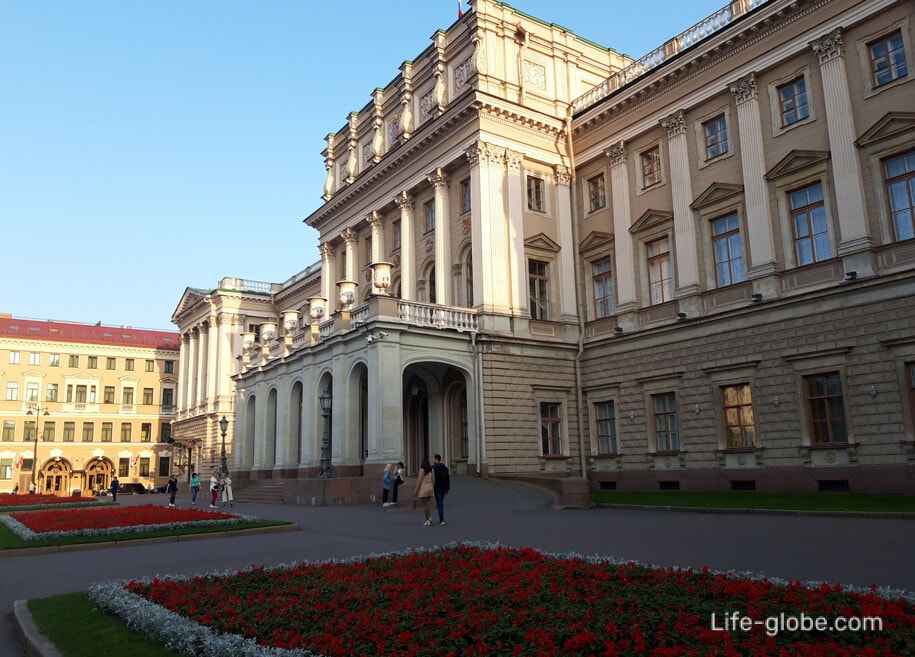
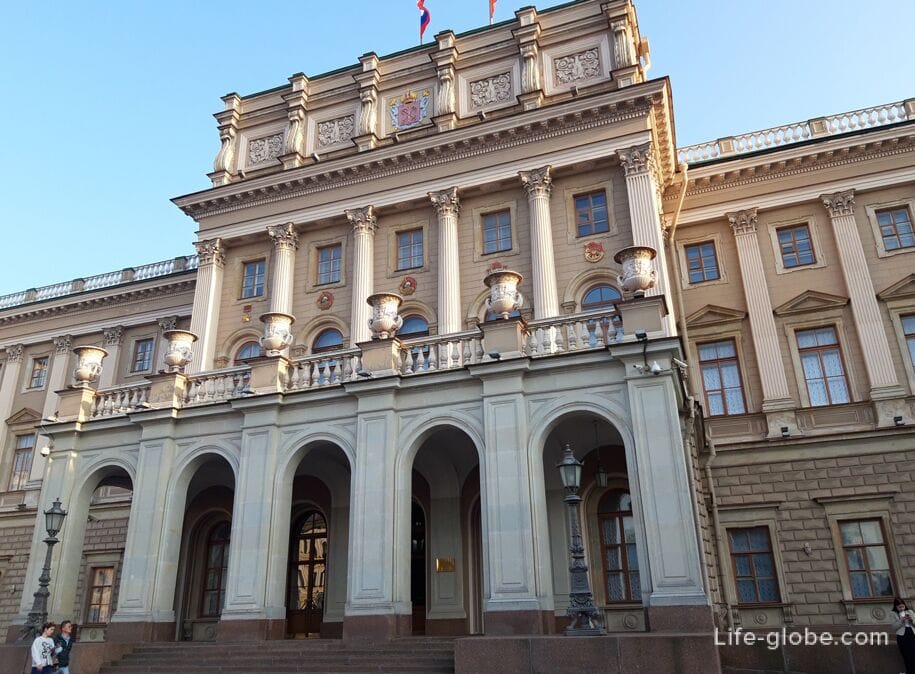
A more voluminous and particularly impressive view of the Mariinsky Palace opens from the observation deck St. Isaac's Cathedral, which is located exactly opposite the palace on St. Isaac's Square. Read more about the observation deck of St. Isaac's Cathedral…
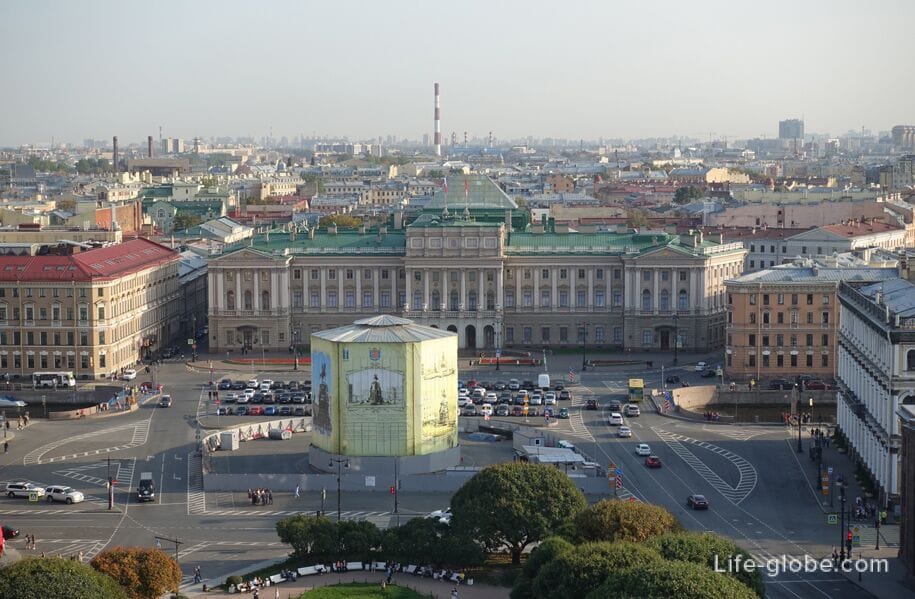
View of St. Isaac's Square, and the Mariinsky Palace, including, from the observation deck of the cathedral
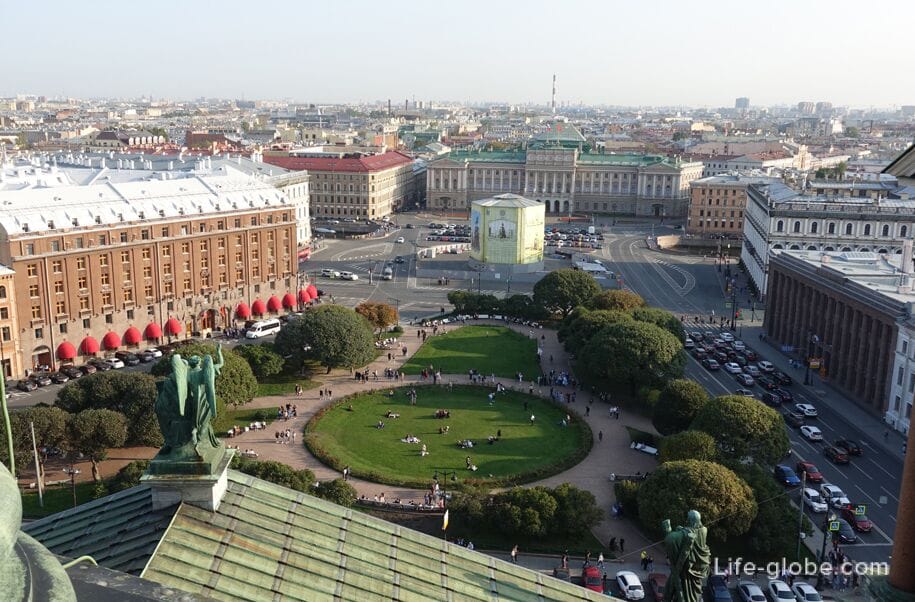
In contrast to the more strictly exterior, the interior of the Mariinsky Palace, which has changed quite a lot over the course of history, has a rich and impressive interior.
The art collections, family jewels and historical rarities that were once in the palace were inherited by the descendants of the Grand Duchess and the duke, who divided the values among themselves and partially exported them abroad. The items that remained in Russia were mostly nationalized-they became exhibits of the Hermitage, the Russian Museum and other state repositories. Some valuable items disappeared during the years of revolutions and wars.
When the grand ducal palace was adapted to the needs of the highest officials of the empire, the personal apartments of the former owners of the "magic castle" (as Anna Tyutcheva called the palace at the Blue Bridge) were changed. Only in some places, individual elements of decoration and decoration, including plafonds and fireplaces, have survived.
Since the late 1960s, the reconstruction of the historic Mariinsky Palace has been carried out systematically (as far as possible, of course). So today, some of the halls and living rooms of the palace have seen the light again.
Entering the main doors of the palace, we find ourselves in the Grand Lobby with columns and pylons made of natural marble of a pinkish hue, which support the high arches.
The lobby floor is lined with ceramic Metlach tiles.
In the lobby, there is a bust of Maria Nikolaevna, the work of the sculptor Galina Dodonova and the architect Elena Lazareva.
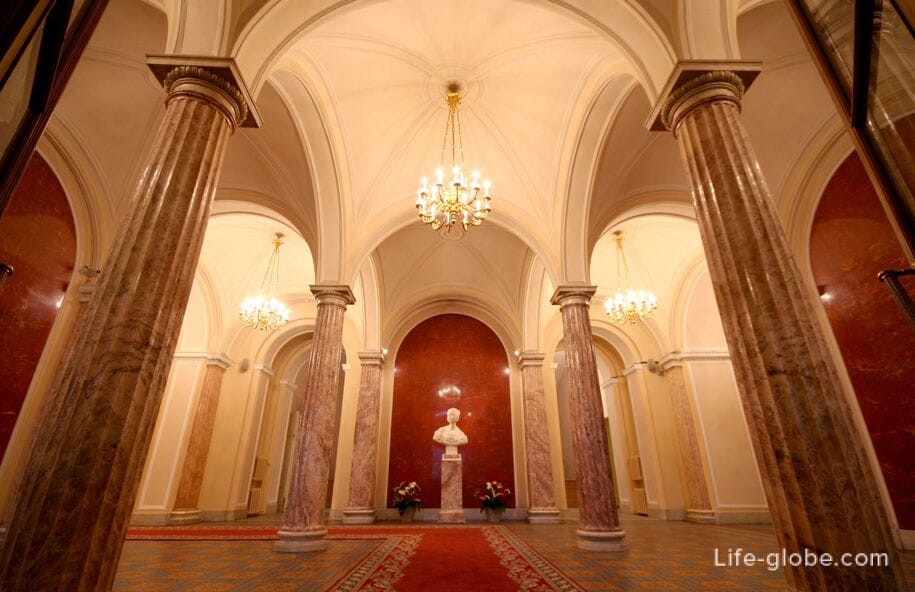
The main entrance hall leads to a small hall decorated with a frieze with a relief depicting the entrance of Alexander the Great to Babylon. This is a cast from the work of the sculptor Bertel Thorvaldsen, who created it for the Quirinale Palace (Palazzo del Quirinale) in Rome, where they arranged lavish apartments for Napoleon in case he came to the city.
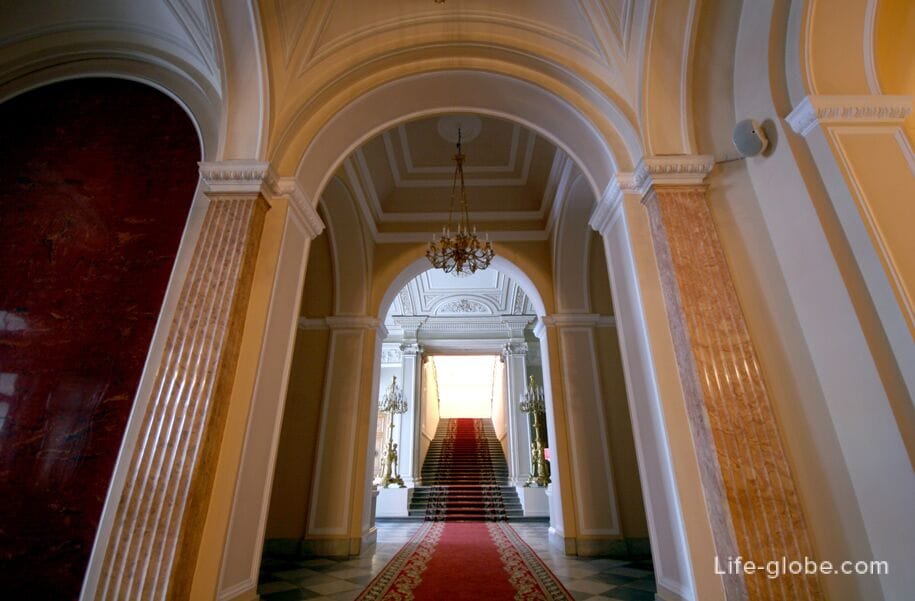
There are also bronze candelabra in the hall, and the walls are decorated with busts of heroes of the Trojan War. In the niches there are statues of ancient warriors.

The ceiling of the hall in front of the Grand Staircase is decorated with stucco gilded ornaments with a pattern of letters forming the name "Maria".

A small entrance hall leads to a wide, ornate grand staircase.
At the middle landing, the staircase splits in two. At the top of the stairs, the two flights of stairs connect. The staircase is framed by openwork cast-iron railings with gilded ornaments.
The walls of the upper landing of the "staircase room" are decorated with pilasters, in the spaces between which there are white busts and gilded masks.
The ceiling is decorated with stucco and picturesque ornaments.

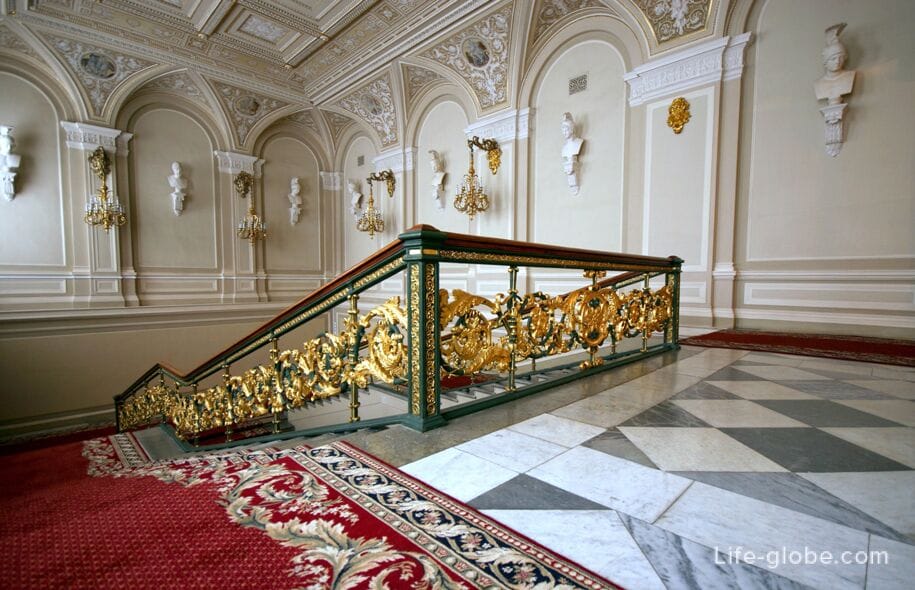
The main decoration of the interior of the palace is the Rotunda-a round room with a height of about 17 meters.
The hall has predominantly white tones and a two-tiered colonnade of 32 fluted columns with capitals.

The light decor of the Rotunda is given by the openwork lattice of the second tier, light stucco and gilding.
The rotunda is crowned with a high dome, through the round central part (window) of which daylight penetrates.
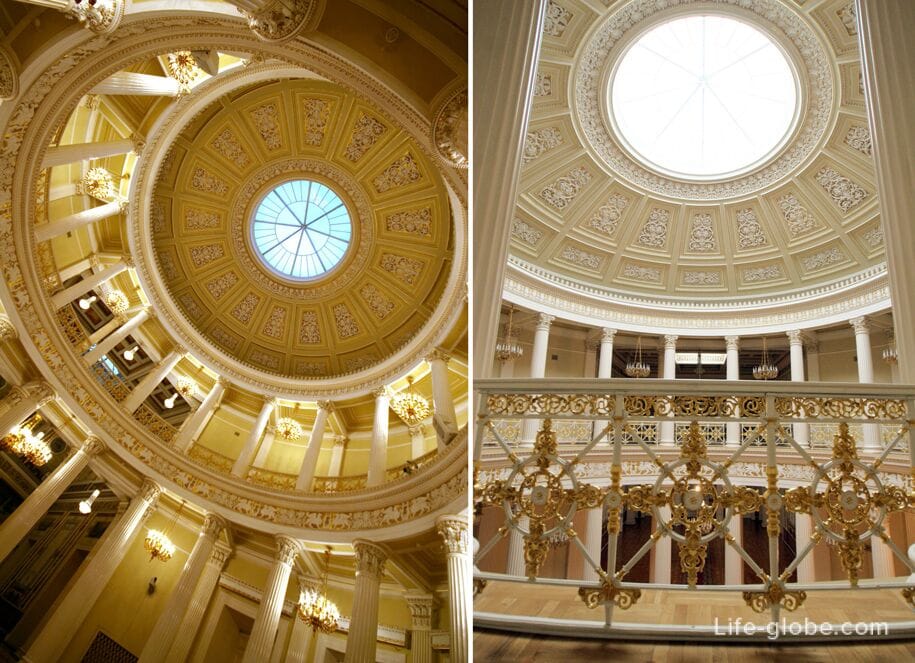
A continuous two-tiered colonnade connects the Rotunda with the Pompeian, or Square, Hall.
This hall is sometimes also called "Dark", because it has no windows.
The name" Pompeian " was given to the hall because of the similarity of its decor with the so - called Pompeian style, which was revered by the architect of the palace-A. I. Stackenschneider.
During his life, Andrey Ivanovich visited the ruins of the city of Pompeii (southern Italy), which was destroyed and covered with a layer of volcanic ash during the eruption of Mount Vesuvius in 79 AD.The architect spent a lot of time on excavations, where he thoroughly studied the finds of archaeologists. He admired the art of the ancient masters, and he began to use these motifs in many of his works (buildings).
The walls of the Pompeii Hall of the Mariinsky Palace are painted in bright colors with gilding in the tempera-glue technique on plaster-completely, from bottom to top. Thanks to this, the walls of the hall are a multicolored carpet, replete with all sorts of images. There are fantastic winged creatures, and girls in chiton, and climbing plants, and cupids.
The ceiling of the hall is deeply coffered (consisting of various recesses and cells), richly decorated with stucco and brightly painted, including the use of gilding.
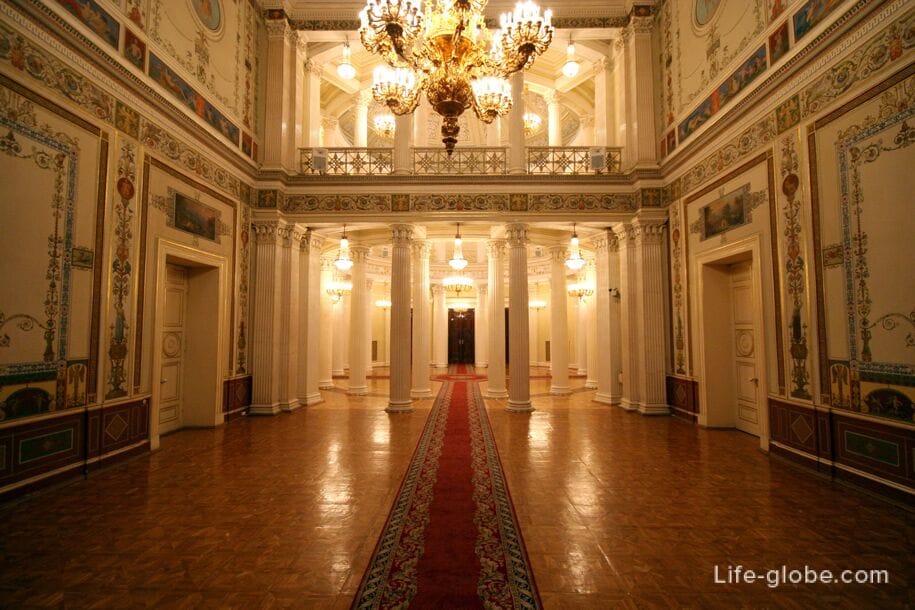
In the Pompeian style, Stackenschneider also created a similar gallery - the Pompeian Corridor of the Mariinsky Palace.
The purpose of the gallery was-a passage, essentially-a corridor between the larger halls: the White Hall and the Duke's Library, which has now been converted into a Blue Meeting Room.
In the gallery, the painting is less dense than in the Pompeian Hall, there is more free space and there are windows, so the entire interior seems lighter and more elegant.
Arches resting on the protrusions of the piers divide the gallery into compartments, covered with domed vaults, which depict fantastic creatures, animals and birds.
The walls depict landscapes in ornamental frames and grotesques in the form of picturesque candelabra.
The windows of the room overlook the courtyard of the palace.
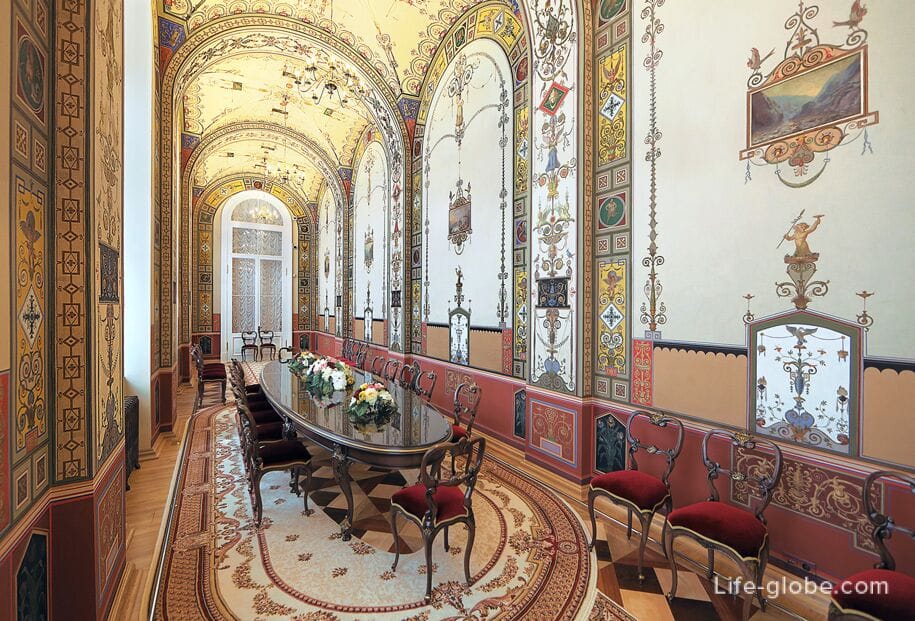
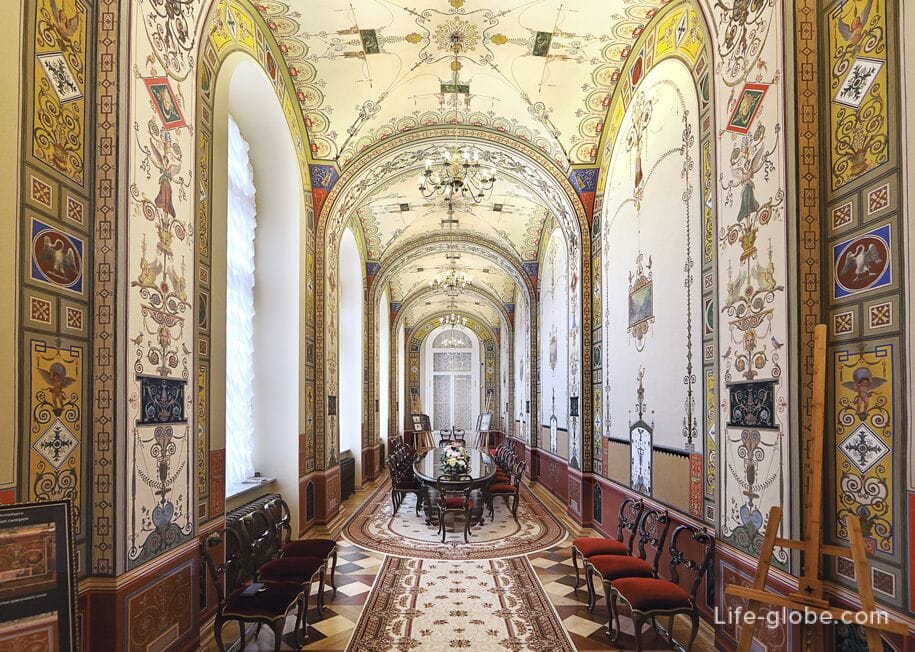
The White Hall is a former dance hall and one of the jewels of the palace, where in former times the Princess and the Duke held formal receptions, balls and concerts.
The walls of the hall are mostly free of decorations. Smooth panels of white artificial marble are bordered by a meander (stucco ornament) in the form of gilded lines with curls and small stucco decorations in the corners.
The ceiling has deep caissons, which are filled with stucco rosettes, leaves and acanthus shoots.
One of the main decorations of the hall is a large picturesque frieze, which depicts scenes from ancient mythology. The frieze was created by the muralist Antonio Vigi.
In the hall there is a marble fireplace with two Ionic columns, on the capitals of which there is a cornice.
The hall is lit by three tiered crystal chandeliers and sconces made at the Imperial Glass Factory.
Under Maria Nikolaevna, the hall had another purpose - an art gallery. In 1850, from Munich was brought a rich collection of works of art, numbering about 300 paintings by outstanding artists of Western Europe (Van Dyck, Rubens, Murillo, Correggio, Albani, Titian, etc.). The brought paintings were decorated with the walls of the Dance Hall and the adjacent Pompeian Gallery.
Today, the hall hosts meetings of the permanent bodies of the Assembly, round tables, parliamentary and public hearings, and conferences.
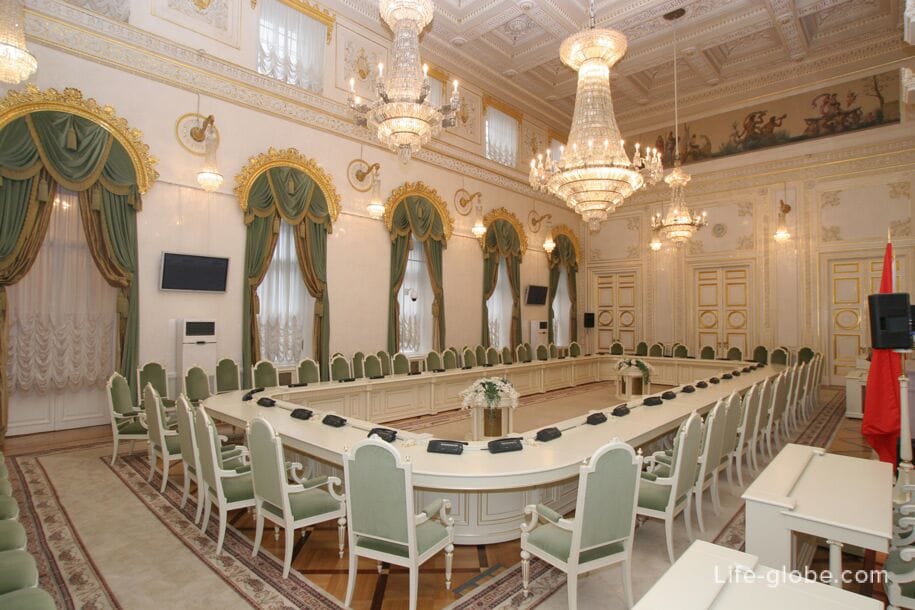
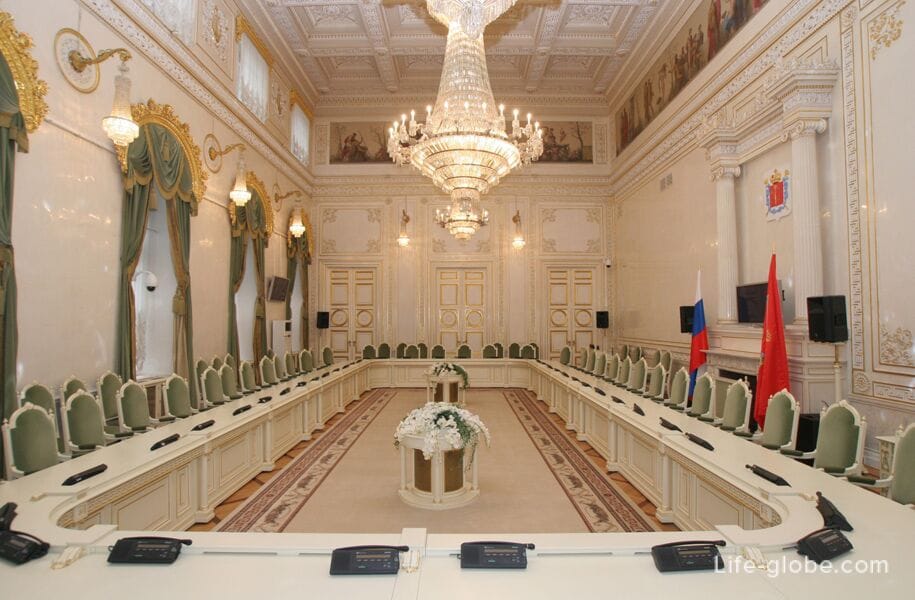
The Red Hall is the former State Reception Room of Maria Nikolaevna's husband, Duke Maximillian of Leuchtenberg.
The hall was named "Red" because its interior is dominated by the dark red color of artificial marble, which is lined with fluted pilasters. This color is pleasantly combined with the white color of the walls and stucco capitals.
The gilding, which is used to decorate many details of the room, makes the hall particularly festive.
The floor is laid with parquet with unusually complex patterns, created from exotic trees.
Seven rosewood doors are decorated with the finest pattern of mother-of-pearl, ivory and gilded bronze. These doors were made in Fortner's workshop in Munich in 1842-1843 and delivered to St. Petersburg by sea in 1844.
The reliefs of the frieze are dedicated to the theme of ancient images.
The hall has two small fireplaces of white Carrara marble with reliefs in the frieze above the furnace and in the side abutments.
The windows of the room overlook St. Isaac's Square.
Today, the Red Hall hosts protocol meetings of deputies of the Legislative Assembly with foreign delegations.
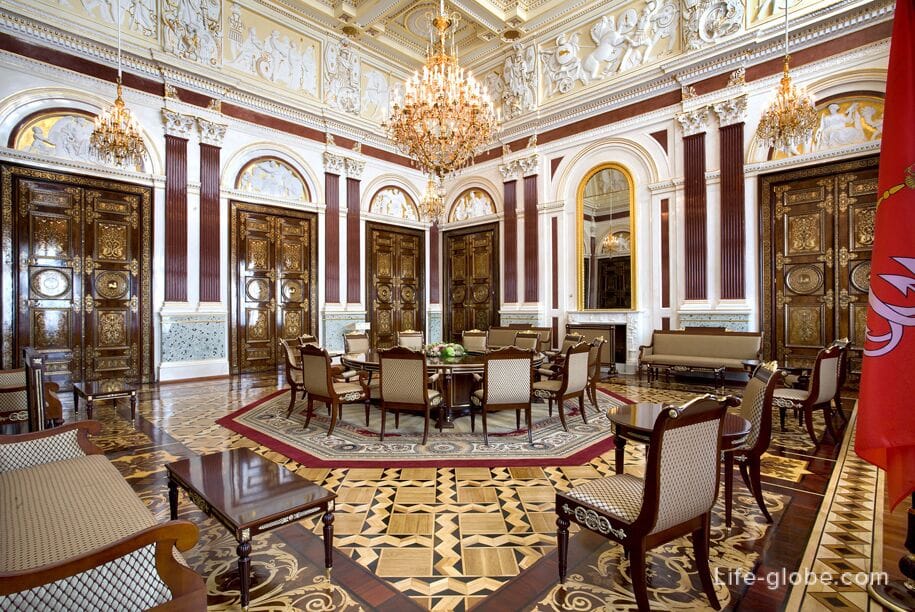
Once in the Mariinsky Palace there was a beautiful two-level winter garden with statues and fountains, flower beds and lush vegetation.
In 1907-1908, the winter garden was rebuilt into a meeting hall of the State Council of the Russian Empire.
In the early 2000s, the interior of the hall was restored. A new modern glass dome was created. Fragments of stucco and decorative elements have been restored in accordance with how they looked in the 19th century.
Meetings of deputies are held in the hall.
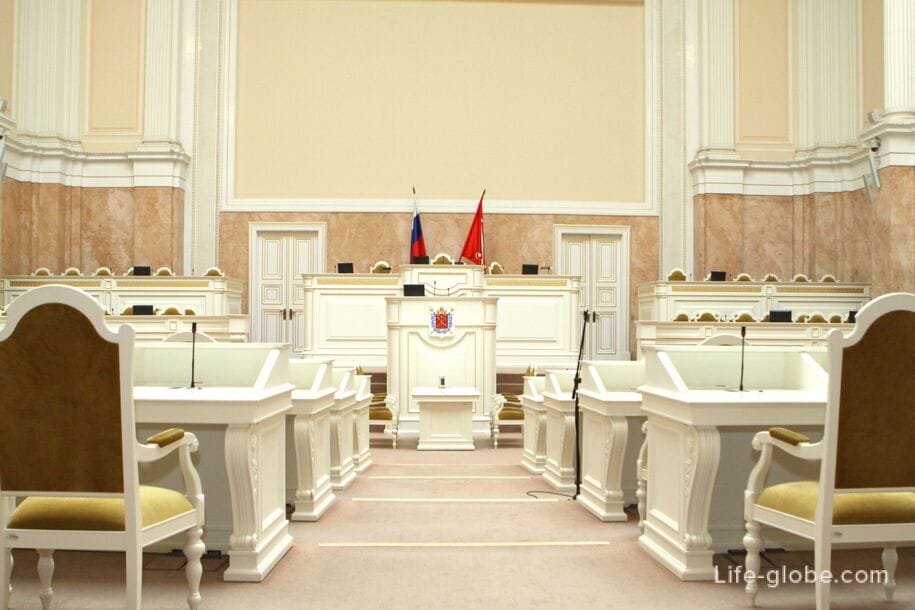
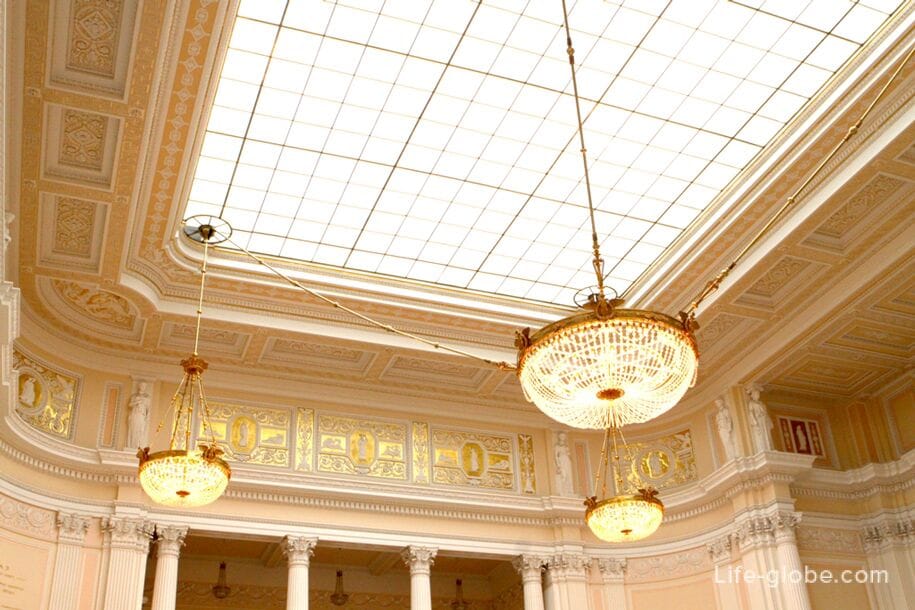
The room is divided into two unequal parts by paired pylons decorated with stucco ornaments on a golden background.
The first-a larger space-was the Living Room, the smaller-the Study, and then the Boudoir. The halls were separated from each other by a heavy curtain, which could be opened to form a single hall.
Stackenschneider defined the style of the hall as "Florentine Renaissance" - the style of the Italian Renaissance.
The simple blue walls are in perfect harmony with the rich stucco work, which covers the upper parts of the walls and the ceiling with almost a solid carpet.
Many St. Petersburg palaces liked to place fireplaces under the windows. This combination of living flames and views of city blocks or rural landscapes excited the romantic people of the 19th century. In this living room of the palace, the fireplace by the window is decorated with mosaics, repeating the plots of mosaics excavated in Pompeii.
The second fireplace in the room is made of Carrara marble, has a relief "Visit to the Volcano by Venus" and recalls the duke's constant scientific studies in mineralogy, mining and electroplating.
Now the hall is used as a storage room for gifts to the city from various delegations on the occasions of anniversaries and other solemn events. The glass cases contain objects from different countries of the world.

Semi-circular office (dining room, Oval office).
The study closes the suite of private rooms of the Grand Duchess.
The windows of the room face the inner garden of the palace and Voznesensky Prospekt.
The window-door of the study opens onto a large balcony, which used to be accessible even in a small carriage by a straight external ramp, later destroyed.
In the room, the multi-tiered fireplace-stove, made of multicolored marble, especially attracts attention. It has a marble panel with a thin graphic image of Venus with a mirror.
The walls are covered with damask. The painting of the vault is admirable and attracts the eye.
An openwork chandelier with crystal replaced the original one, made according to the drawing of Maria Nikolaevna herself.
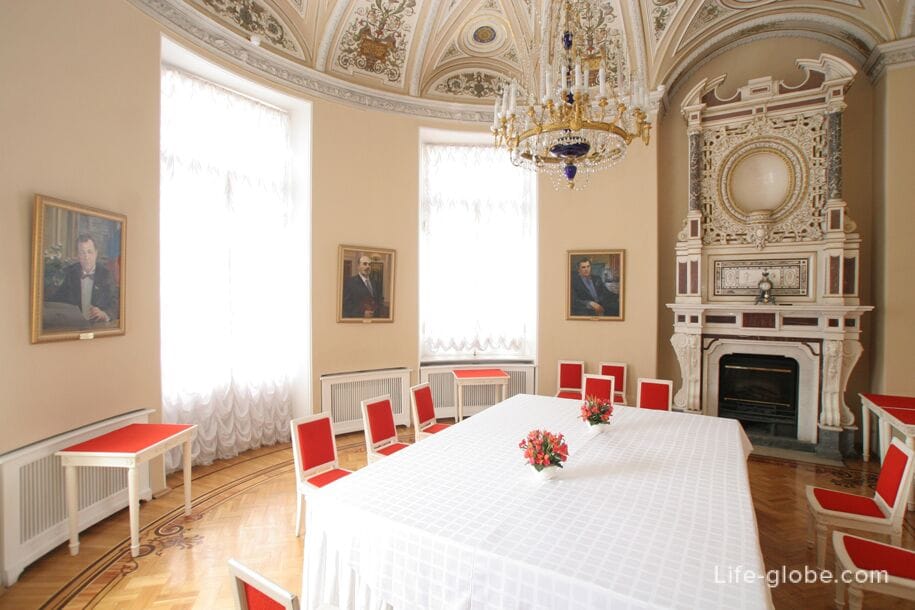
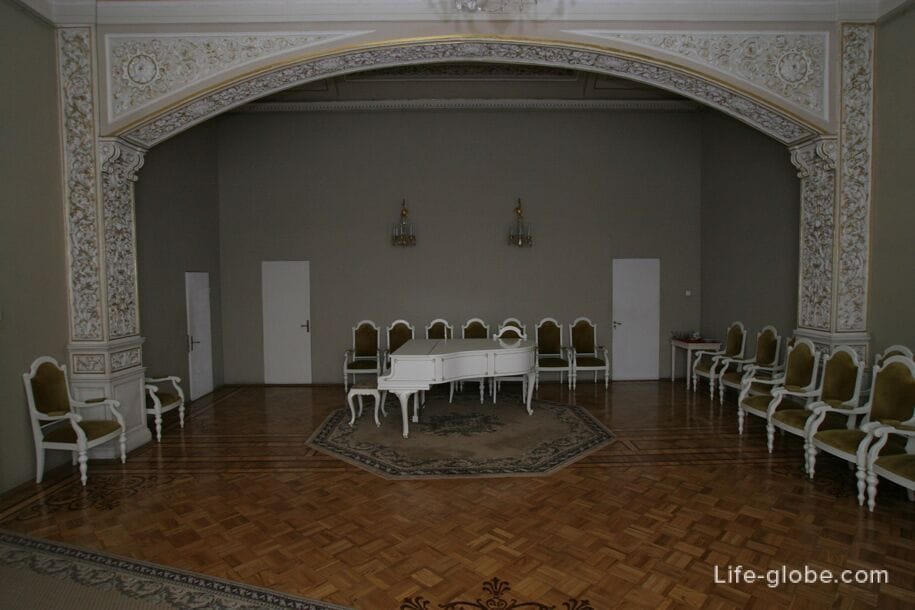

The former small boudoir was located in a tiny room adjacent to the Bathroom and Toilet and connected by a secret door to the Study.
Here the Grand Duchess rested in complete seclusion.
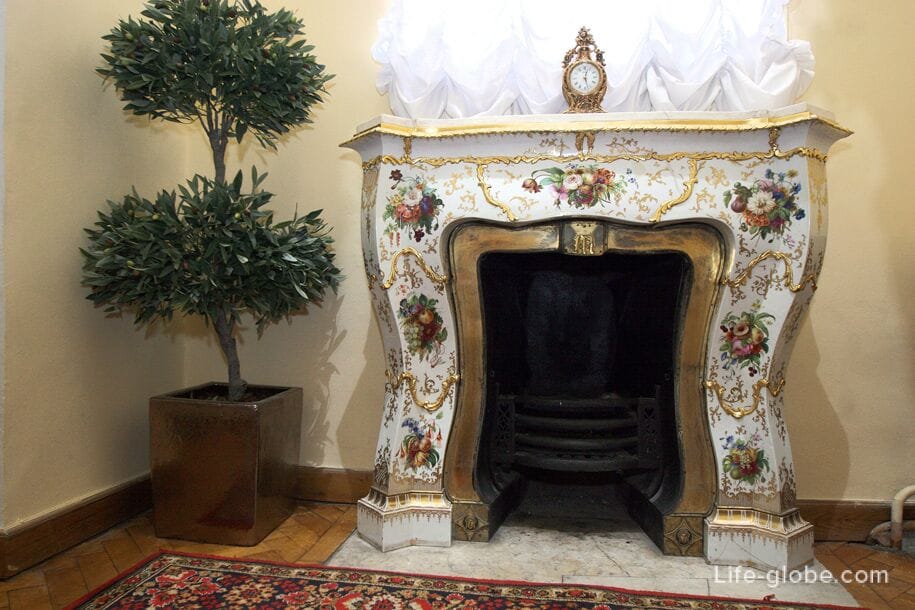
The ramp of the palace-that's what makes you exclaim: "Give me something with wheels!".
The ramp occupies the middle position between the former apartments of Maria Nikolaevna and Duke Maximilian. From here, it was the quickest and easiest way to get to the children's rooms and to the private apartments of their Imperial Highnesses. Thanks to the gentle ascent without steps on the ramp, it was possible to roll the wheelchair on wheels without hindrance.
Maria Nikolaevna's legs were constantly aching, and she often had to move in this way.
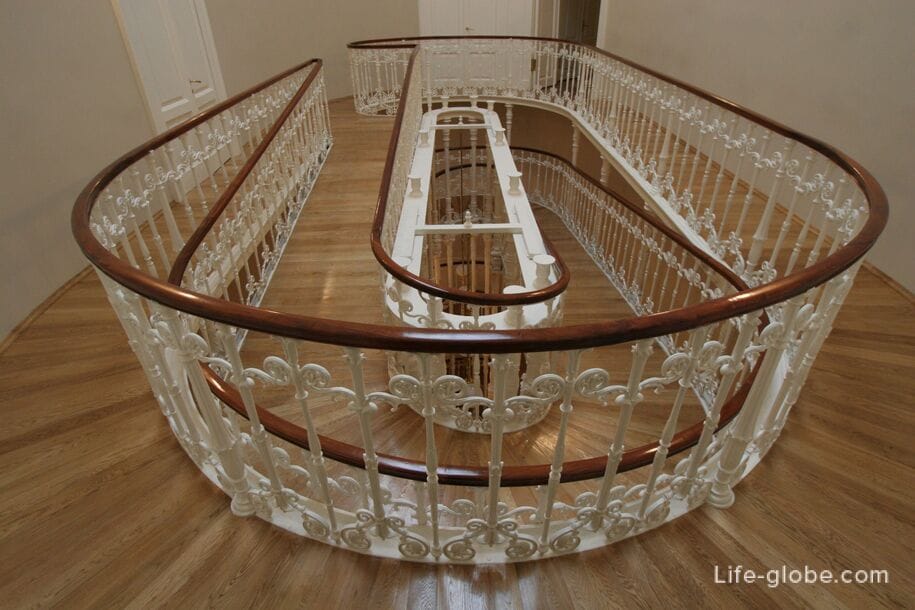
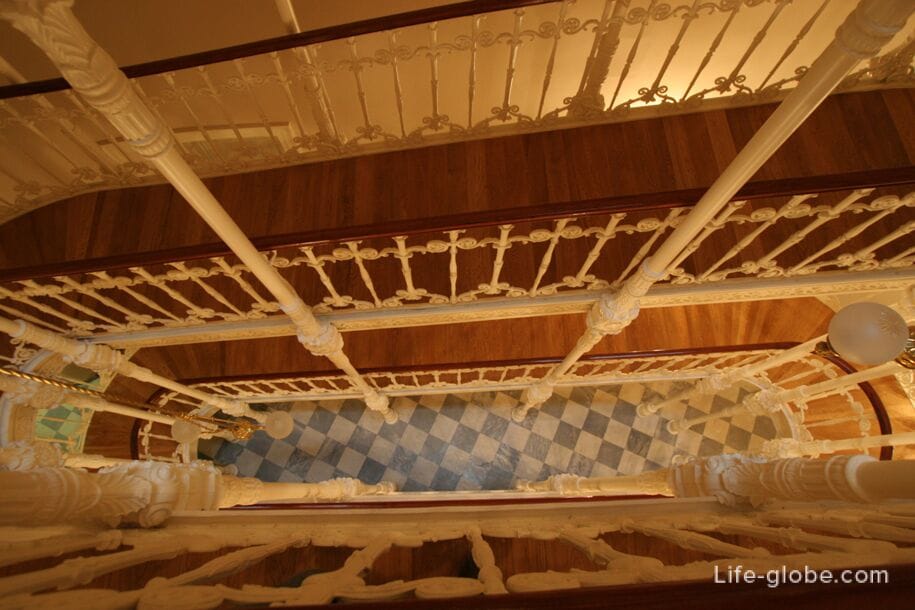
Above all the front, residential and office premises was the palace church-the church in the name of St. Nicholas the Wonderworker, consecrated on January 17, 1845.
Initially, the church was quite modest in its decoration. However, Maria Nikolaevna did not like its simplicity.
In 1856, Maria commissioned Prince Grigory Gagarin to create a new appearance of the palace church. He made a continuous painting of all the walls on the theme of the Old and New Testaments; a new marble iconostasis with icons of saints named after members of the imperial family; transformed the eastern part of the church.
The church was closed in early 1918. Subsequently, its decoration was lost. Only partially preserved wall paintings. The church staircase was also restored and the glass dome above it was recreated.
Since 1991, the clergy of the Kazan Cathedral have held services in the palace church.
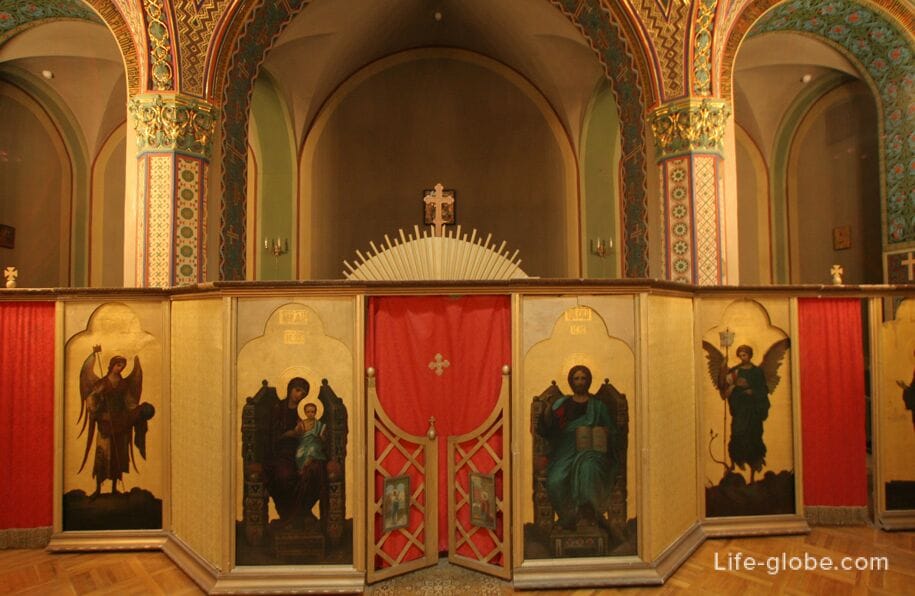
The information and educational parliamentary center of the Legislative Assembly of St. Petersburg is located in the historic building on the first floor of the Mariinsky Palace.
Inside the center there is a model of the Mariinsky Palace and materials on the history of the creation of the palace.
The center's exposition also reflects the history of the creation and formation of the St. Petersburg parliament; shows the development of international and interregional parliamentary relations; provides full information about the Institute of Honorary Citizens of St. Petersburg, etc.
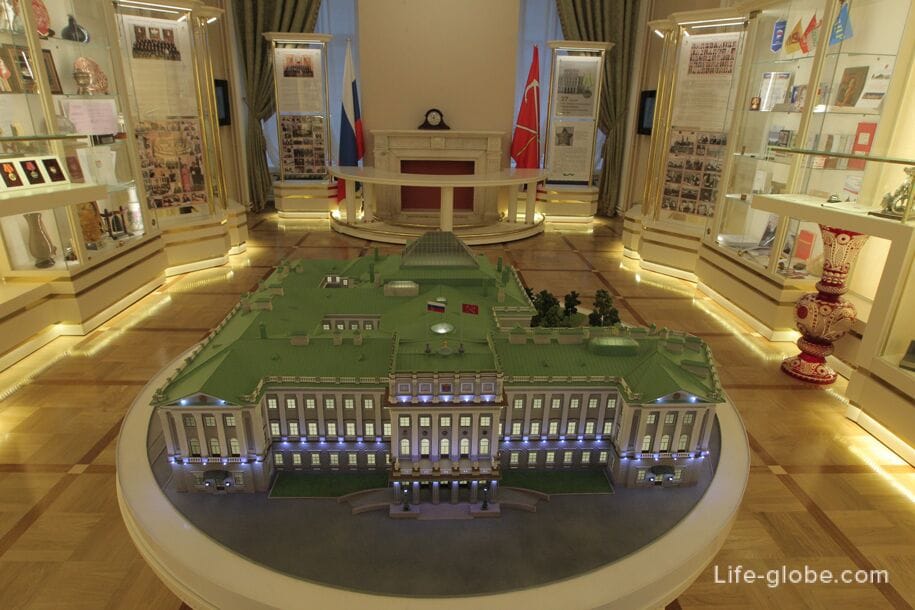
The Mariinsky Palace is located in the very center of St. Petersburg, near the Palace Square, at the address: Isaakievskaya Square, 6.
The Legislative Assembly of St. Petersburg is located within the walls of the Mariinsky Palace.
Also, the palace often hosts various conferences, symposiums, congresses of local, national and international level. Exhibitions, concerts, and ceremonies are organized. The building is visited by groups of tourists and sightseers.
You can also explore the Mariinsky Palace and St. Isaac's Square with one of the excursions in St. Petersburg
On St. Isaac's Square, near the Mariinsky Palace, you can stop:
The 5-star Astoria Rocco Forte Hotelis located in a historic building.
In the hotel: lounge with live music, restaurant, bar, free Wi-Fi, ATM, swimming pool, gym, spa center with sauna and Turkish bath.
Breakfast can be included in the room rate. Link to the hotel
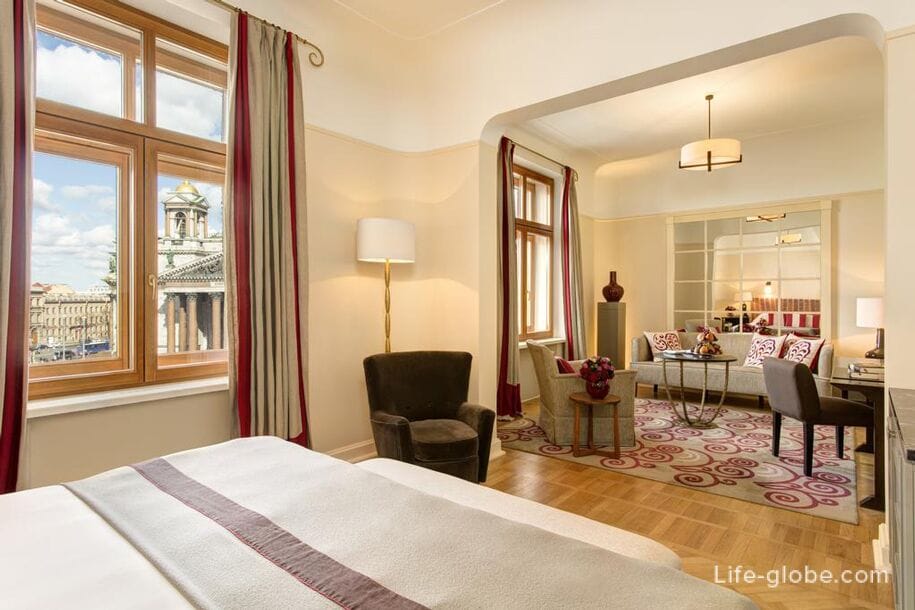
The 5-star Lotte St. Petersburg Hotelis located in a historic mansion on the Moika Embankment.
The rooftop bar offers views of St. Isaac's Cathedral.
Guests can enjoy free access to the modern fitness center and the Mandara Spa's water area.
In the hotel: restaurant, bar, free Wi-Fi and underground parking.
The rooms are equippedwith a coffee/tea maker, a digital panel with which you can control the air conditioning, heating and lighting. The bathroomsare equipped with a bidet, bathrobes, slippers and toiletries.
The suites offer views of St. Isaac's Square and the Mariinsky Palace. A turndown service is available in each room.
Breakfast can be included in the room rate. Link to the hotel
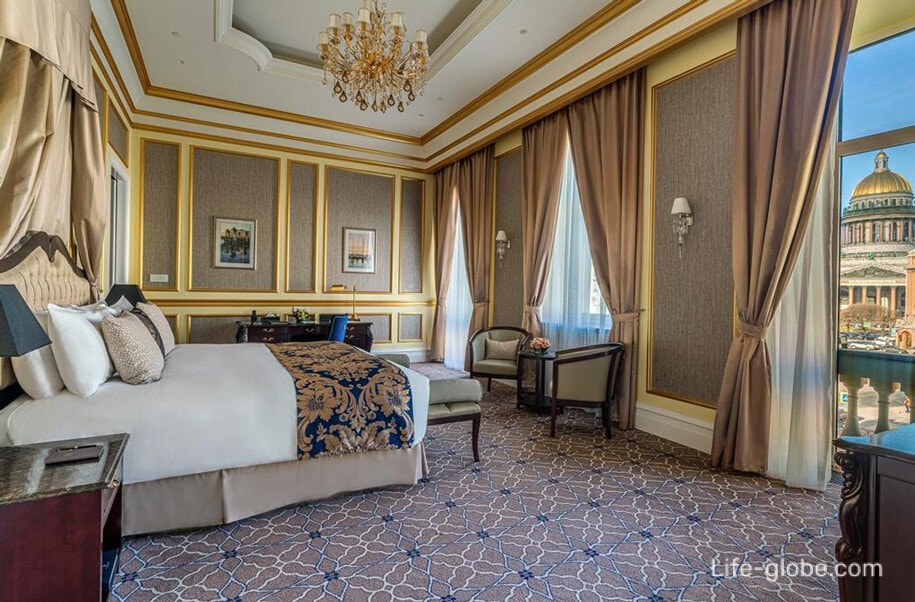
All accommodation facilities in Saint Petersburg, including in the city center and near the Mariinsky Palace, can be viewed and booked here
The Mariinsky Palace was built between 1839 and 1844 by order of Emperor Nicholas I, as a wedding gift for his daughter, Princess Maria Nikolaevna, on the occasion of her wedding to Duke Maximilian-Eugene-Joseph-Napoleon of Leuchtenberg, who for the sake of his wife accepted Russian citizenship.
The architect A. I. Stackenschneider was the author of the project of the palace.
The wedding took place in 1839, and from 1845 the Mariinsky Palace became the official residence of the Princes of Leuchtenberg in St. Petersburg.
So a new center of high-society life appeared in the capital. The palace was often visited by distinguished guests, and Nicholas I himself, according to his compatriots, "every day at certain hours with a slow and stately gait" marched from the Winter Palace (located nearby) to the Mariinsky Palace to see his daughter and first grandson, who was named Nicholas in honor of his grandfather.
Receptions, balls, masquerades, concerts, performances and other events in the Mariinsky Palace were attended by all the St. Petersburg nobility. In addition to entertainment, the family was also actively engaged in public and state activities.
After the death of Maria Nikolaevna in 1876, the palace was inherited by her two younger sons, who in 1884 sold the palace to the treasury.
By the decree of Alexander III, the Mariinsky Palace became the residence of the State Council, the State Chancellery, the Committee of Ministers and the Office for Accepting Petitions to the Highest Name. The building itself was newly furnished and equipped.
On February 11, 1885, the palace was officially consecrated as the center of Russian statehood.
Since 1905, the former building housed the State Council. For this purpose, a new large meeting room was built, which was erected on the site of the Winter Garden - one of the best achievements of Stackenschneider.
After the February Revolution of 1917, the Mariinsky Palace was occupied by the Provisional Government of Russia, which worked within the walls of the palace until July.
On August 7, the All-Russian Commission for Elections to the Constituent Assembly began working within the walls of the palace.
V. D. Nabokov, at that time - the manager of the affairs of the Provisional Government, recalled: "The Mariinsky Palace has undergone a radical "poll". Crowds of shaggy, carelessly dressed people in jackets and shirts of the most proletarian type poured into its luxurious halls. The magnificent footmen, having exchanged their liveries for gray jackets, lost all their representativeness. The solemn ceremony was replaced by a loud bustle."
On the morning of October 25 (November 7, New Style), 1917, revolutionary soldiers and sailors began to surround the Mariinsky Palace. Around noon, they disarmed the junkers who were guarding it, posted their guards, and asked the crowd to clear the premises - everyone obeyed. The Winter Palace was also taken that night.
After the October events, the Mariinsky Palace was taken over by the Supreme Council of the National Economy.
Memorial plaque on the facade of the Mariinsky Palace
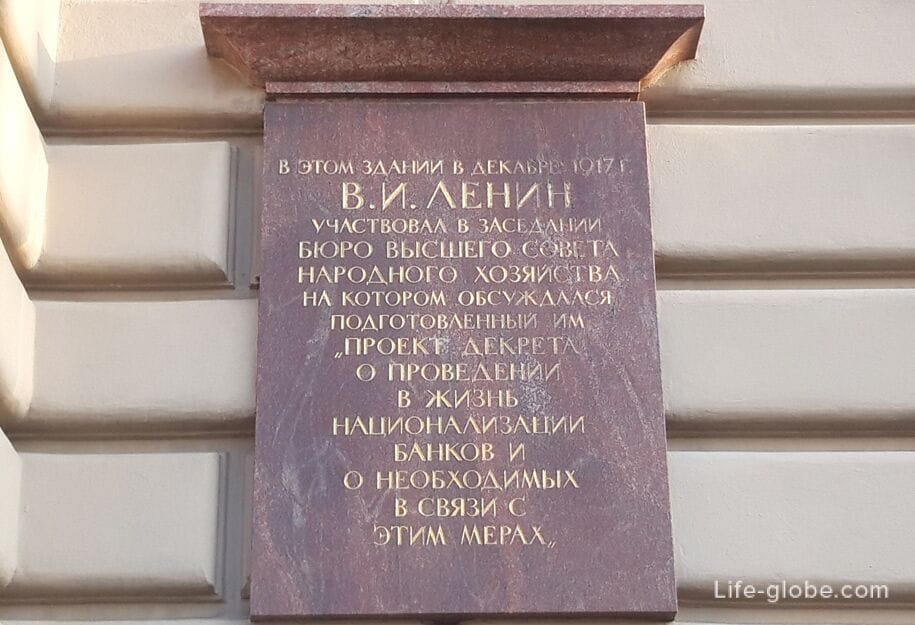
After the government moved to Moscow in March 1918, the Mariinsky Palace housed barracks for the new formations of the Red Army. Later, the palace was occupied by various institutions and societies, then it was turned into a hotel for tourists, later-into a hostel and an audience of students of the Promakademy.
During the Second World War, the palace was the headquarters of the army. A commemorative plaque placed on the facade of the Mariinsky Palace recalls the centenary history of the Leningrad militia.
Also, 4 convalescent battalions were relocated to the palace from the suburbs of Leningrad. Soon their number increased. In official documents of that time, the palace was called "the town of the 1st convalescent brigade".
After the complete liberation of Leningrad from the ring of the enemy blockade, in 1944, the Mariinsky Palace began to be restored from the damage caused by bombing and shelling during the war. During the repair of the damage, a significant reconstruction of the interior of the palace was carried out.
From 1945 to 1991, the Mariinsky Palace was the seat of the city's representative government. For the convenience of the new owners in the building, in its east wing, a marble staircase was built leading to the right lobby; and the rooms were converted into service offices. The works were supervised by the architect M. A. Shepelevsky.
On August 19-22, 1991, during the August putsch, the palace became the center of resistance to the GKChP in Leningrad, and barricades were erected around it. After the failed coup attempt on August 22, 1991, a tricolor banner - the new National Flag of Russia-flew over the Mariinsky Palace.
In 1991-1993, the palace was the meeting place of the Petrograd Soviet. In December 1993, the Petrograd Soviet was dissolved due to the adoption of a new Constitution. Since 1994, the palace has been the meeting place of the City Assembly of St. Petersburg, which was renamed the Legislative Assembly of St. Petersburg.
Today, the building still houses the Legislative Assembly of St. Petersburg, as well as the St. Petersburg Election Commission.